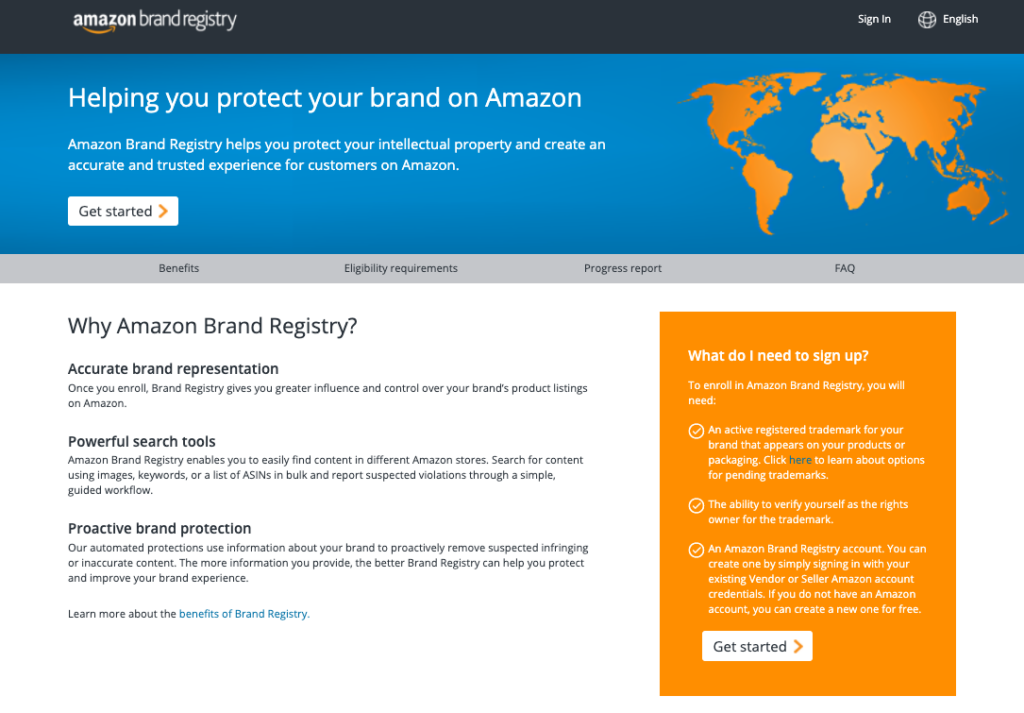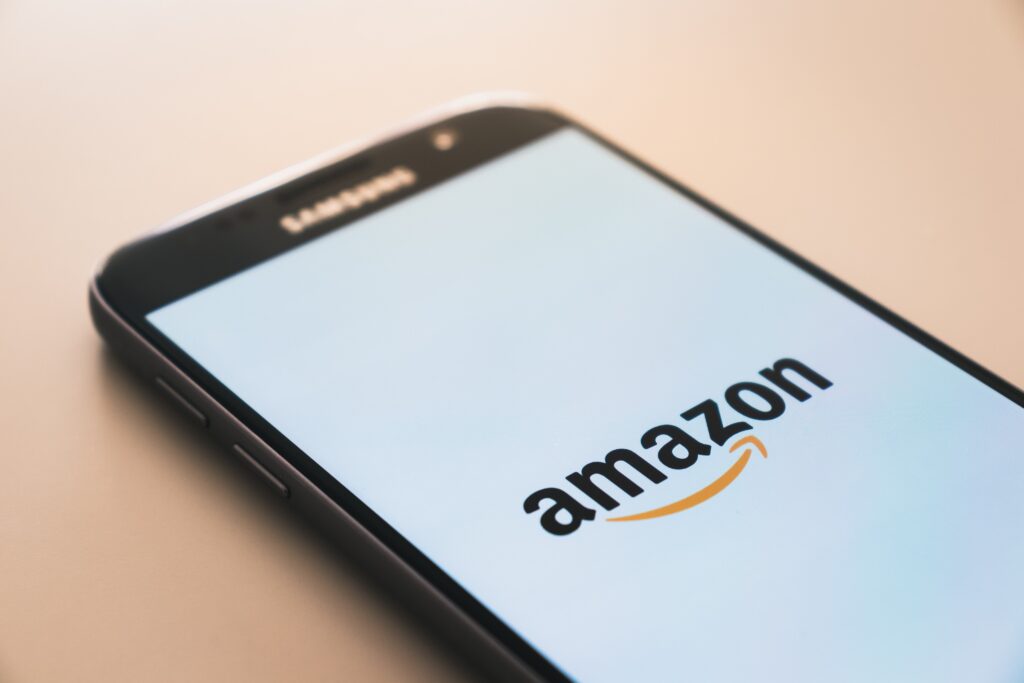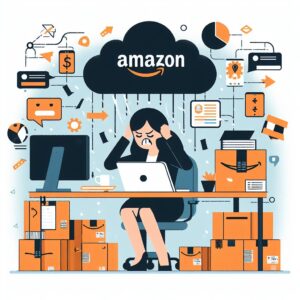With so many sellers flooding Amazon’s platform on a daily basis, it can be easy for some brands to become nervous about their reputation and products getting entangled with counterfeits, dishonest sellers, and misrepresented customer brand experiences. Amazon understands these fears. That is why Amazon launched Brand Registry which is a program that gives verified brands more control over their branding and storefront across Amazon’s platform.
Since its inception, Amazon has continuously improved upon their original concept and created a suite of tools that help businesses on Amazon grow and build their presence. This is a highly recommended feature to enroll in for sellers on Amazon that are interested in protecting their intellectual property.
What is Amazon Brand Registry?

Amazon’s Brand Registry is a program that helps brands protect their ideas and products by utilizing trademark, copyright, and patent protection. It allows verified brands to quickly identify violations and misuse while also providing resources for expanding customer reach and relationships.
Purpose
Before Amazon’s Brand Registry was created, Amazon was facing multiple lawsuits from brands who were upset with their inaction in preventing the distribution of counterfeit products as well as not protecting them from other violations regarding intellectual property. Amazon created a Brand Registry to remediate these issues and place more control into the hands of brand owners.
How Does Amazon Brand Registry Work?
This process works through an enrollment period which helps identify brand owners to Amazon. This program is staffed by a team of dedicated Amazon employees and experts that handle cases regarding stolen intellectual property, policy violations, and listing or technical issues.
The original version of Brand Registry came with multiple problems especially as product and brand hijackers abused the program. Since then, Amazon has worked to improve this experience for its sellers and customers that shows their dedication towards their sellers who are serious about creating brands. A few of the measures they implemented include:
- Separate and dedicated user login and interface that does not tie back to Seller Central.
- Advanced reporting tools for brands to submit counterfeit products or listings.
- Search capabilities that allow brands to seek out products that may be violating copyrights, policies, or trademarks.
- Agent adding capabilities which allow designated users access to tools in the Brand Registry.
- A distinct team at Amazon who solely handles reported violations.
Benefits of Amazon Brand Registry
The benefits of utilizing Amazon’s Brand Registry is that sellers will be able to keep a comprehensive eye over their listings and their brands. This allows brands to easily track any product, trademark or copyright misuse or violation while focusing on what is important to them-growing their brand. Brand Registry comes with many features that help sellers optimize their products and listings and build a solid customer base.
Additional Benefits That Come with Brand Registry
There are a variety of additional programs that sellers can access alongside proactive brand protection. These include powerful advertising tools and store monitoring capabilities.
A+ Content

A+ Content allows brand owners to tell stories about their products in an enhanced way. This tool allows sellers to describe product features using unique stories, images, and text placements. Utilizing this tool has been shown to result in higher conversion rates, anywhere from a 7-11% increase. Reference this Amazon resource to get started with configuring your modules.
Amazon Vine
Amazon Vine gives participating vendors an opportunity to gather honest reviews from a community of Amazon’s most trusted reviewers. These reviewers are chosen based on their reviewer rank and offer valuable benefits to vendors who are looking for opinions that may help boost their product and brand experience. Bear in mind that these reviews come directly from the Amazon Vine community and cannot be influenced or edited by the brand.
Improved Amazon Store
There are a couple of nice features that Amazon Brand Registry supplies those that are successfully enrolled into the program. Among them include ways of boosting a brand’s virtual storefront and providing customers with more extensive overviews of products and services.This is accomplished through the option to add videos to Amazon listings alongside images. Vendors are also able to build store pages that showcase all of the products being offered and create a more cohesive storytelling experience for their brand. Live streams have also become an available feature which allows brands to interact with their customers in real-time and give live demonstrations of their products.
SEO and Advertising
Putting in the work for advertising is an obvious aspect of running a business. But, Amazon’s Brand Registry helps its vendors out with key aspects of this process. With search term optimization capabilities and a larger variety of ad displays, Brand Registry participants can more easily expand their customer base. Vendors will have the opportunity to utilize sponsored brand banners as well as sponsored displays to attract attention to their brands. Both of these options will give businesses some added level of creative control when it comes to advertising.
Tracking and Analytics
Enrolling in Amazon’s Brand Registry also opens up analytics and tracking tools within Seller Central and Vendor Central. This includes a customized Brand Dashboard that allows vendors to see how competitive their prices are, Amazon Prime eligibility of products, and an in-stock rate. On top of these features within the dashboard, brands will have access to data insights that show them information from products that are being browsed most often to conversion rates.
Virtual Bundles
This tool allows brands to create product bundles by combining complementary Amazon Standard Identification Numbers (ASINs). These unique numbers identify items and products and allow for brand owners to offer bundles which can be purchased together without requiring the brand to pre-package them together for Amazon.
Requirements for Enrollment
Enrolling for Amazon’s Brand Registry is simple and comes at no cost to the vendor. This can be done by any entity that has a registered active text or image-based trademark. This trademark is something that must appear on all products or packaging that is sold by the brand. Because every country is different, make sure to double check that you are meeting your country’s eligibility requirements. Amazon makes it easy for vendors with a specific link that addresses eligibility requirements by country.
Those that do not have an active registered trademark can submit a pending trademark application through Amazon IP Accelerator. This tool helps businesses obtain intellectual property rights to their brand by connecting them to law firms who specialize in intellectual property. Read this Amazon blog post for more information about the IP Accelerator.
In addition to providing a trademark, brands must be able to verify that they are the rightful owner of the business. This can be done through the public contact listed on the brand’s trademark registration.
How to Sign Up
After reviewing the preliminary eligibility requirements, brands can begin the process of signing up for Amazon Brand Registry. Remember that these applications can only be submitted by trademark owners who are verified through the brand’s trademark registration.
Once the requirements are met, brands can sign into their existing Seller Central or Vendor Central accounts. It is extremely important that brands do this on behalf of themselves rather than letting agencies or third-party sellers register their brand for them. These entities can be added as “agents” or “sub-users” at a later time.
The last step is to enroll the brand or brands into Amazon’s Brand Registry. To do so, vendors will need to be able to provide Amazon with the following information:
- Brand name with active registered trademark that shows on products and packaging
- Trademark registration number
- List of product categories where brand should be listed
- List of countries where the products are made and distributed
Once these materials are submitted, Amazon will review each application and grant enrollment status to those they believe have met the criteria. This approval process varies but most people can be approved within 24 hours if the teams at Amazon aren’t too busy. For a more extensive look into how to get started, visit Amazon’s easy three step list for how to get enrolled in their Brand Registry.
Product Distribution Control Tactics
Remember that enrolling in Amazon’s Brand Registry does not prevent other vendors from selling products from a certain brand. While Amazon does play a large role in helping brands automatically flag infringements, they do not enforce or stop many distribution issues. It is the responsibility of the brand to control their own distribution and enforce things such as Minimum Advertised Price (MAP) or stop gray imports. Amazon’s Brand Registry only works to protect listing content. Those looking for strategies to control distribution to utilize some of these tactics.
Transparency by Amazon
Those that experience consistent counterfeit product issues can also look into Transparency. This is a proactive counterfeit protection service that works through implementing product serialization. This process gives customers the ability to authenticate any product that has been “Transparency-enabled” as well as access product information like manufacturing dates, locations, or ingredients. Customers can easily find this information when they scan Transparency codes of the product through the app.
Transparency works in a few simple steps. First, brand products need to be enrolled into Transparency. Then, item specific Transparency codes need to be applied to each product. Lastly, these products can be authenticated on Amazon’s end before items are shipped and also on the customer end, regardless of where the product was purchased.
Brand Gating
Also known as restricted branding, this is where third-party sellers need to be approved before being allowed to sell a brand or its products. This allows brands to retain control over their distribution and labels. Sellers usually need to have invoices or letters of approval from brands to prove their background as well as paying a potential fee. Brand gating limits counterfeit products and prevents unauthorized resellers from selling a brand’s merchandise.
To get a brand gated, companies need to enroll in Amazon’s Brand Registry and then contact the local seller support with information about the brand. Using an IP lawyer can help with this process and you can use Amazon’s IP Accelerator to get in touch with IP experts. Make sure to forward a list of any authorized third party sellers as well as a priority list of ASINs if you are trying to take immediate action. Ultimately, Amazon will brand gate everything within a brand once everything is submitted and reviewed.
Amazon Project Zero
This anti-counterfeit program works to reduce the amount of counterfeiting through three main components. Project Zero was originally available to ten countries but has recently expanded to include seven additional countries and is eligible for Brand Registry enrolled brands that meet a certain criteria. Besides holding the rights to the trademark, brands must have had 90% of their potential infringement reports approved by Amazon within a six month period.
Amazon Project Zero targets these areas to decrease the amount of counterfeit products.
- Automated protections. This works by using the information that brands provide as key data points to use in automated, daily scans of the billions of listings on Amazon’s platform. This
- Self-service counterfeit removal. This allows brands to personally remove counterfeit listings from stores without needing to go through Amazon. This information is also reutilized by the machine learning, automated potections process.
- Product serialization. Unique codes are applied to items to verify authenticity of every product before it reaches the customer.
Brands that are qualified for Brand Registry enrollment can reap plenty of benefits from its programs and features. And, as Amazon continues to grow as a leader in the e-commerce industry, it will only continue to improve upon what they offer their brands in terms of maximizing sales and autonomy over brands. There are plenty of areas and tools to explore when it comes to Amazon’s Brand Registry, all of which will only go towards building your brand. You can visit seller forums on Amazon’s Seller Central to find more advice on the brand registry and ask any additional questions you may have.
Screenshots taken by author, August 2020.






